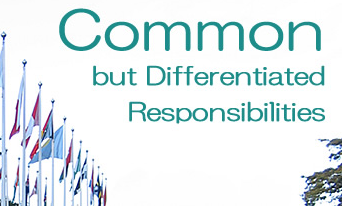The Principle of CBDR-RC in Climate Jurisprudence


The Principle of CBDR-RC in Climate Jurisprudence
The concept of CBDR-RC has evolved from the notion of the ‘common heritage of mankind’. The principle recognizes historical differences in the contributions of developed and developing States to the creation of global environmental problems like climate change, and global warming. At the same time, the principle also recognizes the differences in the economic and technical capacities of developed and developing countries to tackle these problems. Common but Differentiated Responsibilities and Respective Capabilities (CBDR–RC) is a principle within the United Nations Framework Convention on Climate Change (UNFCCC) that acknowledges the different capabilities and differing responsibilities of individual countries in addressing climate change. The concept of Common But Differentiated Responsibilities (CBDR) was enshrined as Principle 7 of the Rio Declaration at the first Rio Earth Summit in 1992. The declaration states: “In view of the different contributions to global environmental degradation, States have common but differentiated responsibilities. The CBDR concept has evolved into CBDR-RC with the addition of the Respective Capacities term to it, in the Paris Accord. CBDR-RC principle, has since then been a key element in international environmental agreements involving climate change. The basic understanding of CBDR-RC can be understood in the essence that all states have a shared obligation to address global environmental destruction but are not equally responsible. Developed countries that have been historical polluters have greater responsibility in addressing the climate change problem.
The history of the principle of CBDR
The principle of CBDR has been said to have been originally propounded in the “Convention for the Establishment of an Inter-American Tropical Tuna Commission of 1949” which for the first time stated the notion of “common concern”. The UN Resolution of 1967 further substantiated the expression of concern for the loss of natural resources belonging to all (especially maritime, such as whales and tuna). The need to establish variegated levels at which different states can effectively enter into a collective response, according to both their capacities and their levels of contribution to the problem, had been recognized since the first UN conference on the environment, in 1972 also known as the Stockholm Declaration. The 1992 deliberation which formalized CBDR revolved around two older notions of environmental governance - “common responsibility” spoke directly to the notion of the “common heritage of mankind”. The Rio Summit of 1992 revolved around four main themes - deforestation, climate change, desertification, and biodiversity degradation. These environmental problems and its global repercussions brought home the need for a collective response, which needed in turn to be grounded in a common responsibility which led to the formalization of CBDR in the spheres of climate and climate justice. In simple legal language, CBDR propounded after 1992 describes the shared obligation of two or more states toward the protection of a particular environmental resource.
Developments in the principle of CBDR - The Kyoto Protocol
The establishment of CBDR has always led to the conflict of distinguishing between different parties, particularly for the sake of the right to carbon emission and the right to sustainable development. The Kyoto Protocol of 1997, unlike the earlier treaties, established legally binding obligations for developed countries to reduce their greenhouse gas emissions. The Kyoto Protocol made a classification between parties based on their commitments. The two categories of the division of countries were between the ones polluting since the industrial revolution like the US, UK, Japan, etc and the recently polluting developing countries like China, India, Brazil etc. The parties under these commitments were grouped under 5 Annexes - Annex I, Annex II, Annex B, Non-Annex I, and the Least Developed Countries (LDCs). With countries given specific targets under their category; fulfillment of these targets mainly by keeping greenhouse emissions below their quota as permitted by the categorization would help gain carbon credit to the nations. These credits could be traded at a price fixed by the United Nations Environment Programme from time to time. Kyoto Protocol adopted the top-down approach in allocating duties and rights with respect to CBDR according to the differentiation of Annex I and non-Annex I countries. The rigid dichotomy in naming the countries under the two differences made the CBDR mechanism a complex one as several major polluters evaded responsibilities that should have been accrued to them in accordance with their emissions.
The Momentous Step - Paris Agreement (2015)
The adoption of the Paris Agreement and Sustainable Development Goals (SDGs) made 2015 a momentous year for the international community. The objective was to strengthen the global response to the threat of climate change, through sustainable development with the goal to restrict the global temperature increase to below 2 degrees Celsius above pre-industrial levels and a desirable goal of 1.5 degrees Celsius. The Paris Agreement exclusively stated that the process towards the desired goal must be implemented in light of different national circumstances. This was based on equity, justice and principle of common but differentiated responsibilities and respective capabilities (CBDR-RC). Article 9 of the Paris Agreement is typically important in which states ‘developed country Parties shall provide financial resources to assist developing country Parties with respect to both mitigation and adaptation in continuation of their existing obligations under the Convention. This was in line with the Kyoto Protocol which also called for financial assistance from the financially developed to the more vulnerable. The Paris Agreement opened up the bottom-up approach unlike the Kyoto Protocol’s top-down approach. In a way, the Paris Agreement superseded the Kyoto Protocol as a global response to climate change.
The Paris Agreement - Evolution of the CBDR
The principle of CBDR-RC acknowledges different nations have different capacities and duties to climate action. The Nationally Determined Contributions (NDCs) are commitments that countries make as a part of climate change mitigation to reduce their greenhouse emissions. Article 3 of the treaty postulates that nations individually. The nations are required to submit their own NDCs which reflect their capabilities, priorities and national circumstances. These NDCs are reviewed every five years and accordingly upscaled to tackle climate change. This mechanism for assessing this led to the establishment of the Global Stocktake with its first evaluation set in the year 2023. The main idea is expressed in the ratcheting up of ambition in emission cuts and allowing the NDCs to evolve in a way that expresses the country's “highest possible ambition”. Alongside, climate financing was also proposed to strike a balance between adaptation and mitigation. The developed countries poll up funds in these initiatives. Focus on adaptation measures would greatly help the Least Developed Countries in adjusting to the perils of climate change.
Conclusion
The principle of CBDR has indeed come a long way after the 1992 Earth Summit at Rio. With the first instance of its application displayed in the Kyoto Protocol of 1997, the development of CBDR into CBDR-RC came about in the Paris Agreement of 2015. A lot needs to be done. The global climate funds on the adoption measures have fallen woefully short of targets. A clear example is the “Loss and Damage” fund which was designed to support vulnerable nations facing the brunt of climate induced changes. The contributions made to these funds by the bigger polluters around the clone depicts the sad state of responsibility sharing when it comes to owning responsibilities for actions. The problems relating to adaptation related measures were out in the open even in the COP28, recently concluded at Dubai. The problems with responsibility sharing persists with many major polluters trying to evade responsibilities under the “least developed countries” categories which has made most of the process of climate justice redundant. The points of “luxury emissions” on the part of the developing countries and “unfair economic advantage” accounting to developed countries have further spiced up the “common but differentiated responsibilities” debate. The principle has been evolving and one can always think that further deliberations in the upcomings COPs would be able to weed out the problems related with fixing of responsibilities according to respective nation’s capacities.
ABOUT THE AUTHOR
Atul Pal is an Indian-based lawyer practicing in the High Court of Delhi. He has pursued his LLM in Public International Law from the London School of Economics and Political Science and his LLB from Delhi University".
